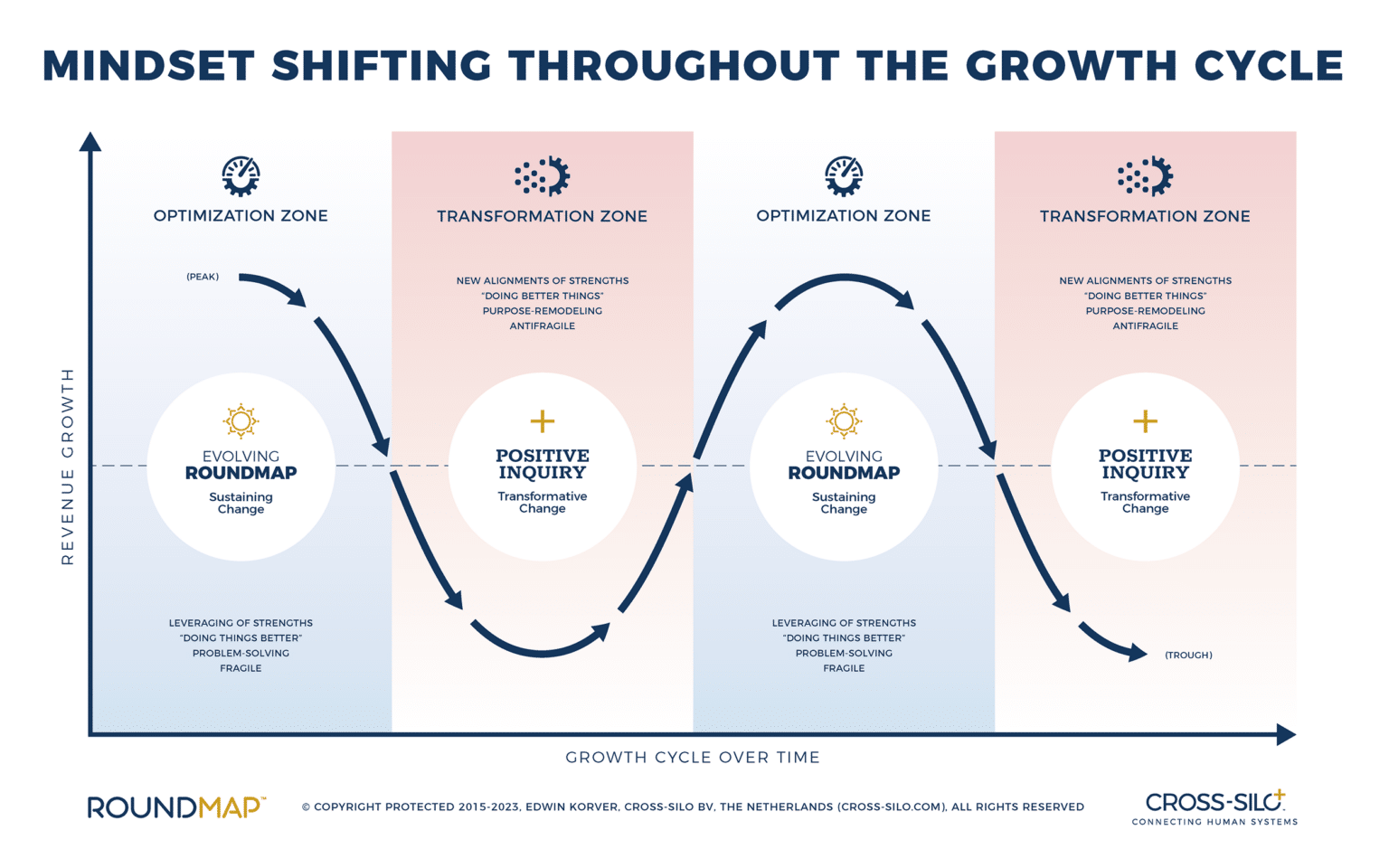Considering the intricacies of cyclical management, we’ve devised a visual representation of the K-wave, the technology-driven business cycle based on economic studies by renowned economists like Kondratieff, Schumpeter, and Perez. Recognizing that K-waves encompass four distinct phases, we’ve streamlined this complexity by categorizing these stages into two primary zones: the Optimization Zone and the Transformation Zone.
It’s important to realize that most sectors and industries are currently in a Transformation Zone and will likely remain there for the next 5 to 10 years. Let’s consider the visual representation:
The wave-shaped line represents the transient cycle of growth and decline as it passes through the Optimization and Transformation Zone. During the Optimization Zone, the focus is often on incremental improvements, so-called sustaining innovation. When growth declines, and all attempts to turn the tide have been exhausted, the focus must shift to finding better ways to grow. In the Transformation Zone, firms must shift their priorities and KPIs from reductionists’ efficiencies to constructionists’ potentialities. This sets the stage for disruptive innovation, igniting a cycle of innovation and disruption.
However, when growth declines, most executives resort to cost restructuring, believing they can and should turn the trend. By doing so, they risk delaying the transformation beyond a point of recovery, often resulting in massive layoffs. While some loss of jobs may be unavoidable during downturns, an unplanned loss of knowledge and experience can have a long-lasting negative effect on the organization’s future performance.
Interpreting Market Dynamics for Business Adaptability
At the heart of business adaptability lies the ability of various departments to read and interpret market signals. With its finger on the pulse of market dynamics, the Sales Operation often recognizes the onset of product lifecycle decline. Once all strategies to rejuvenate or extend this lifecycle seem unfruitful, pivoting becomes more of a necessity than a choice.
On a parallel track, the Service Operation provides valuable feedback on customer satisfaction. When a product or service no longer aligns with evolving customer expectations, it’s an alarming indication that the business may become obsolete in its value proposition.
Furthermore, for companies with a storied legacy, there’s a genuine risk of losing their edge if they don’t continually reassess their impact. Kodak, once a giant in its domain, stands as a cautionary tale. A business must not only deliver value but also ensure that this value remains significant in the changing landscape of customers’ lives.
The signals for a potential pivot can come from various operational fronts. Recognizing and acting on these signals timely can be the difference between sustained success and gradual obsolescence.
Recognizing Catalysts for Strategic Innovation Shifts
- Market Saturation: If a company finds that its market is becoming saturated, and incremental changes no longer provide a competitive edge, it might be time to think disruptively. When further improvements to an existing product line yield diminishing returns, a disruptive approach can open new markets or redefine existing ones.
- Technological Advancements: Rapid advancements in technology can create opportunities for disruptive innovations. If your company is at the forefront of a technological breakthrough or can leverage one, it may be advantageous to pursue disruptive innovation.
- Changing Customer Needs: If there’s a noticeable shift in customer behaviors, preferences, or unmet needs, it can be an indicator that the market is ripe for disruption. Listening to customers and spotting these trends early can offer a first-mover advantage.
- Economic Shifts: Economic downturns or changes in the macroeconomic environment can create conditions where disruptive innovations become more viable. These shifts might render traditional products or services less attractive, while novel, cost-effective solutions gain traction.
- Organizational Readiness: Internally, if a company has the resources, culture, and risk appetite to venture into unknown territories, it might be well-positioned to drive disruptive innovation.
- Competitive Landscape: A stagnant or slow-moving competitive landscape can be a golden opportunity for companies to introduce disruptive solutions. If competitors are only focusing on incremental changes, a disruptive move can capture significant market share.
- Decreasing Margins: If profit margins are declining despite sustaining innovations, it might indicate that the current business model or offerings are reaching their limits. This scenario can be a trigger to explore disruptive avenues.

